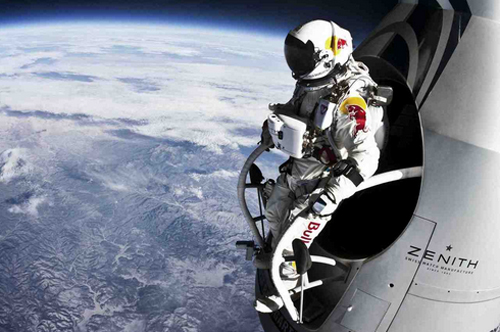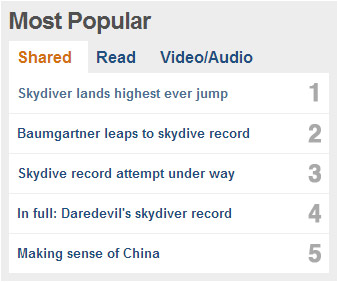Craig Charley
15 Oct 2012
Red Bull Stratos - The First Global Social Media Event?
On Sunday 14th October, Felix Baumgartner jumped out of a balloon 24 miles above the planet, breaking the speed of sound and a few world records to boot. It was an impressive feat, pushing the human body to new limits and showing what people are capable of achieving.
Watch the jump!
Not loading? Click here to watch on YouTube.
Red Bull Stratos was a collaborative event, with the previous record holder for sky diving - 84 year old Joe Kittinger - guiding Felix from the ground, a whole team supporting and organising the jump, and just a bit of help from the sponsor Red Bull. It was also what I believe to be the first truly global social media event. Read on to find out what I mean by that...
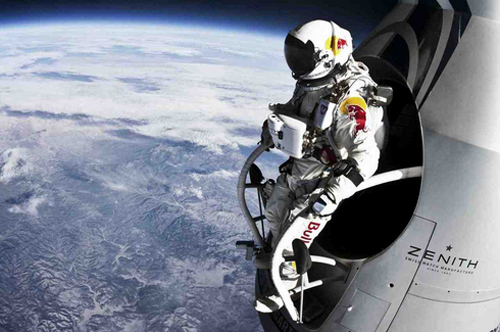
If you want to find out more about the jump itself, head to the Red Bull Stratos website or the BBC where it's proving quite a popular subject today, claiming 4 out the top 5 most shared stories:
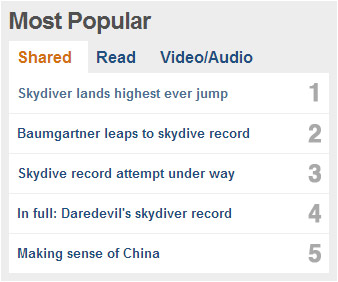
Want to publicise events like Red Bull? We offer tailored social media training packages. Combine our social media, content marketing and WordPress courses to learn how to build a website and create and marketing content using social media.
Red Bull the Brand
Since its creation in 1987, Red Bull has become one of the world's leading brands - which seems inconceivable considering that they have only ever sold one product - a fizzy drink.
Okay, Coca Cola have done this as well, but they had a 100 year head start and own over 500 separate brands. Red Bull have done it with one.
However, for many people, Red Bull doesn't just conjure up an energy drink - they are just as well known for their various sponsorship arms - Formula 1 (Red Bull Racing), flying (Red Bull Air Race), football (New York Red Bulls), extreme sports and even a music label!
Red Bull are renowned for their sponsorship and award winning advertising, but they are also gaining a lot of applause in social media, currently sitting at the top of Star Count's Brand Chart and regularly making the top 10 weekly chart:
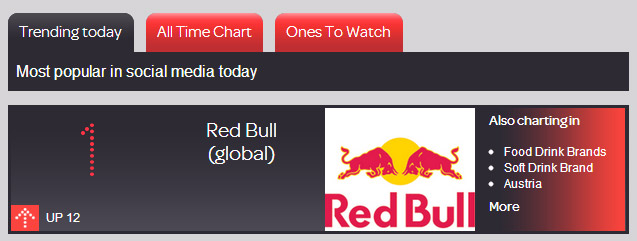
So Red Bull have been doing social media well for a while now - posting up attractive shareable content that makes you go 'wow'. This month though, they've taken it to the next level with Red Bull Stratos.
The Red Bull Stratos Broadcasting Challenge
Broadcasters are always trying to control social media engagement during programs - BBC and ITV both place program specific hashtags onscreen during shows and presenters encourage viewers to share. This feels a lot like an add-on rather than a well thought out strategy and the broadcasters are often ignored. However, Red Bull's Stratos broadcast was entirely built around social media. That is why I call it the first global social media event.
A huge social media campaign was vital to the success of the Red Bull Stratos broadcast. Unlike traditional live media, there was no set date or time for the jump - it was entirely dependent on weather conditions. There was no TV spot to plug - although the jump was broadcast live on TV round the world on News Channels. Red Bull had to rely on social media to let people know when Felix Baumgartner was actually jumping, something they did very well. The challenge became even harder as the first attempt on the 9th October had to be cancelled as the conditions were not right - disappointing millions who had been glued to the YouTube stream for hours throughout the day.
YouTube was an important part of the Red Bull Stratos coverage, despite the recency of live YouTube broadcasting. It allowed Red Bull to stream the event when it suited them, turning on the cameras whenever they wanted without having to wait for the world's media to catch up. Websites round the world embedded the feed onto their sites, each in turn publicising the event themselves and getting more eyes on screens.
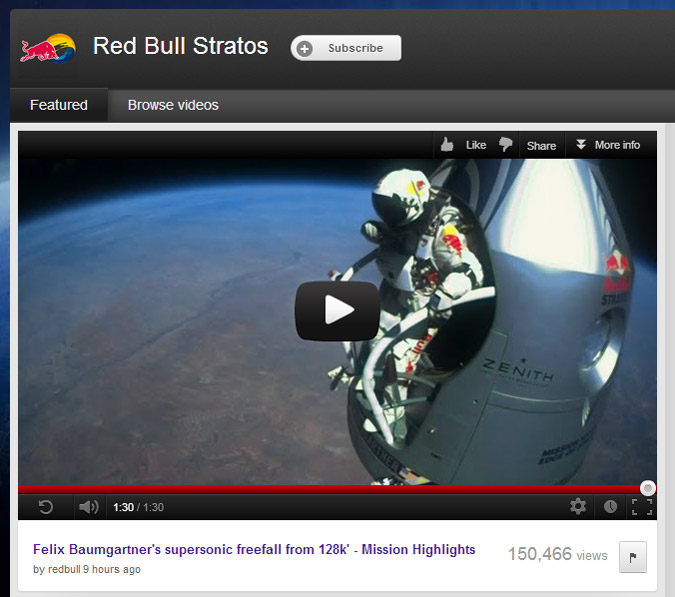
Live broadcasting on YouTube is something to keep an eye on - mostly it has been restricted to music events but Red Bull have proved that it can be used as an effective marketing tool. I can see more and more broadcasters being tempted away from the restrictive nature of TV channels by the potential virality of online broadcasting.
Momentum built on social media channels - especially Facebook and Twitter - on the day of the actual jump with over 8 million people tuned into the live YouTube stream at the time of the actual jump. To get 8 million people watching an event that was only confirmed as happening two days before is an impressive achievement.
So how did Red Bull use the power of social media to gather interest in the jump and make sure that millions were watching?
Shareable Content = Shareable Website
Red Bull built an event specific website to promote the jump, featuring a wealth of content to please all sorts of people, from the impressive stats to the science behind the jump.
Here's a screenshot of the site from last week:
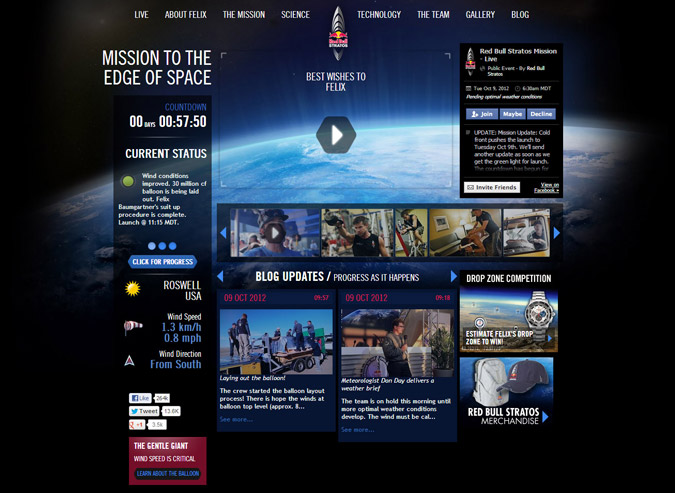
There's video, there's photos, a blog, statistics, countdown, competition, merchandise and each of those navigation links is a drop down to page after page of content.
Most impressive is the Mission Timeline page - an interactive scrolling page with moving elements to demonstrate each stage of the jump.
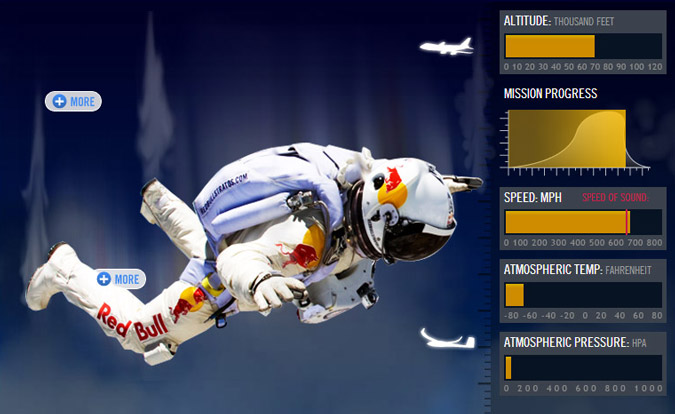
To be honest, Red Bull could have just had one page that said in large, bold, capital letters 'THERE'S A MAN SKY DIVING FROM SPACE' and it would have been shared, but by constructing a site full of content they encouraged even the most reluctant sharer to see something cool and post it on Facebook or Twitter - and that's the next thing they did well...
Twitter and Facebook Integration
If you have been on the site, you'll have noticed that everything has social share buttons. These are connected to the Red Bull Stratos Facebook page (671k likes) and the Red Bull Stratos Twitter (241k followers). Interestingly, Red Bull decided to go for separate accounts rather than use their primary accounts. This is a good move as it means that they can keep the two separate with more frequent updates on the event specific pages while the main pages continue to post about the full spectrum of Red Bull news.
Live updates helped the event really go viral, here are the 'safely landed' posts, showing that those watching the jump were also actively engaging at the time:
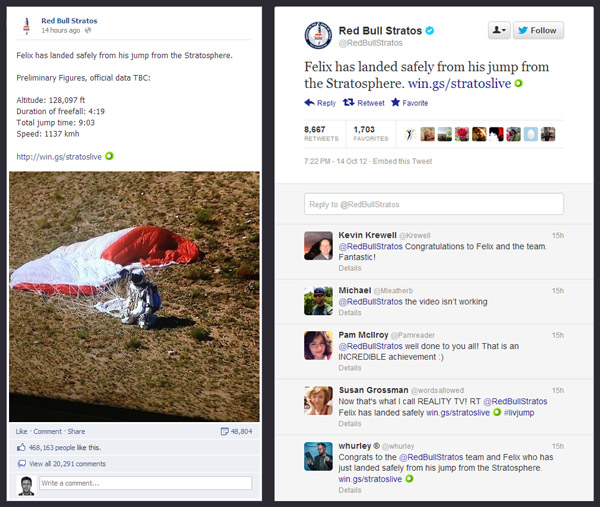
Red Bull always do particularly well on Facebook, their posts usually contain a high quality image with very little text and a link. They want people to look and share, not to read.
During the jump, Felix was trending on all social networks and Google and Bing both had the jump as a popular topic. Red Bull made this easier by suggesting two hashtags! Not quite sure why, but it was a nice touch that neither of them was branded:

This is something that Red Bull has been applauded for. The logo may have been all over everything to do with the jump, but the sponsorship didn't feel pushy. During the hours of broadcast, the only time Red Bull was even mentioned was in the name of the event - there was no in your face advertising. I'm not sure Coca Cola would have been so restrained and would have expected an ad for the drink every half hour or so!
Here is the Trendmap during the first aborted attempt to demonstrate just how global the event was:
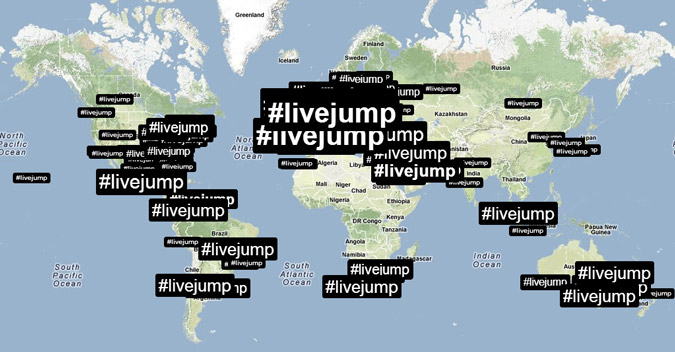
Yep, trending in Hawaii!
What We Can Learn from Red Bull Stratos?
Red Bull provides a great example of how to do social marketing well. Here are some of the key things to learn:
- Do something awesome - People only share cool stuff. If it's not shareable, it's not worth doing.
- Think outside the box - There are only so many ways to sell an energy drink. Be creative with your marketing.
- Integrate social - Make it easy for people to share your content, get those buttons in action - but don't go OTT.
- Drive engagement yourself - Don't sit back and wait for people to talk about you or your product - get in there and drive engagement yourself on social media channels. Provide people with something to share.
- Content, content, content - Give people something to consume and to share. Create the information that people are searching for, but don't bother creating anything that's not in some way useful.
The BBC are now busily preparing a special documentary on Felix's jump with loads of unseen HD footage, expect that to appear in around a month's time. I can't wait.
